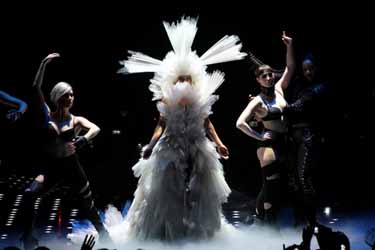Singing, Dancing, Performing: The Pressure on Women Artists to Be Extreme
Industry and societal pressures push women to two character extremes: the innocent, sweet girl-next-door type or the crazy, wild party animal.

Hannah Weintraub is a 17-year-old high school student and one of Rewire’s youth voices.
I used to play guitar. Then, one day, I exclaimed to a friend that I didn’t need to learn how to play guitar anymore. I was happy to just find someone to play with me as I sang. He shook his head and said to me, “A girl who can sing and play an instrument: She is unstoppable.”
Unfortunately, this statement is too frequently untrue. More often than not, even the girl who can sing and play must have just the right look and just the right expression of gender, and also a touch of crazy, in order to make waves. Otherwise, the music industry has the tendency to tear girls up and put them back together into a more “acceptable” artist.
The music industry has seen so many young women crash and burn that I’m surprised these artists haven’t earned their own genre on iTunes. Here are just a few high-profile “troubled artist” examples: Amy Winehouse died of alcohol poisoning, Britney Spears received psychiatric treatment, and Demi Lovato went to rehab.
It’s hard to tell if the music and entertainment industry attracts women who already have a high propensity for erratic behavior or if the general pressure of the environment pushes them into it. At any rate, media and advertisers seem to be interested in dictating the behavior of mainstream women artists in a way that doesn’t apply to their male counterparts. These pressures push women to two character extremes: the innocent, sweet girl-next-door type or the crazy, wild party animal. There are few women performers who can stand somewhere in the middle of these polarizing personas. What if a star dares to fall from her predetermined character mold? People from all areas ogle and judge her as if it is an astronomical malady.
This pressure to conform to a specific archetype does not just come from the media. The push also comes from companies that peddle an artist’s reputation as if it were a product itself. Some brands even capitalize on the unusual and tragic antics of a singer to generate hype for themselves. A recent article in the New York Times explained that many companies use popularity scores to select their spokeswomen. Interestingly, certain higher-end beauty and fashion companies, such as MAC cosmetics, are more inclined to hire more controversial stars with lower scores to represent their products. So does Lady Gaga, who has a line with MAC, always feel it in her heart to be a meat-wearing “monster,” or is the lure of advertiser money part of the inspiration to wear unusual outfits and act out?
On the other extreme, outside forces still push women artists, especially those with young fan bases, to remain pure and pristine. When Miley Cyrus began to branch out into the world of “naughty” adulthood—semi-nude photos, marijuana, alleged pole dancing—tabloids and fans rose up in an attempt to rein her in and squeeze her back into the innocent, girlish mold that she had previously inhabited. Many young women artists become stuck in this limbo between angelic childhood and demonic adulthood, and often they too are pressured to uphold their submissive, virtuous veneer. Taylor Swift is just beginning to bridge this gap, and the New York Times suggests that is only a matter of time until we see if she will be able to make the jump.
While women artists must contend with the poking and prodding of companies and fans as they develop their personalities, male artists are left relatively up to their own devices. Of course anyone in the entertainment industry faces pressure to act in a certain way, regardless of gender. However, people often associate “crazy” with women artists such as Ke$ha. At the same time, people also associate “pure and sweet” with women artists, like Miranda Cosgrove. Male artists we more often know by just their names.
This double standard is often clearly evident at the Grammy awards. This year the band Fun. performed in casual suits and ties. At the 2010 show, P!nk performed in a nude body suit as she dangled from the ceiling. This is just one example of men wearing everyday clothes and women wearing extreme outfits during performances. Perhaps it takes extra effort for a woman to gain attention and get ahead. For the most part, male artists can wear everyday clothes and still do fine on the charts.
Of course there are exceptions to this pressure. Historically, the farther out of the mainstream an artist is, the more control she has over her persona—take, for example, punk feminist rock stars. However, what message is this sending? Why does a woman who wants to assert her own personality have to be “alternative”?
When I was a small child, my bedtime songs were from the songbooks of Joan Baez and Joni Mitchell. Their stories of answers blowing in the wind and painted ponies that go up and down captivated me. What also amazed me about these women was that they didn’t let anyone dictate what they would sing or how they would act, and people loved them for it.
Today, these women represent a type of freedom that isn’t always displayed or allowed in mainstream music. The women who supplied my nighttime songs gave me dreams that maybe a girl who can sing and play an instrument can be unstoppable.
